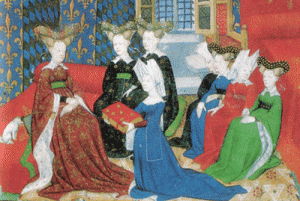Christine de Pizan and the ‘Querelle des femmes’
By Claire Jones
Christine de Pizan’s choices and achievements were highly unusual for a woman in the male dominated culture of the Middle Ages. At a time when unflattering opinions about women were widely spread by writers, sovaldi the church and followers of the ‘courtly’ code, cialis sale Christine defended women from slanderous accusations and argued against negative views of women’s duplicitous nature.
Christine also followed a pattern by breaking out of contemporary female stereotypes when she was widowed in c 1390. Then, nurse when the necessity to earn money to support her children become imperative, she also acquired the freedom and independence that only widows enjoyed (widows were no longer subject to their husbands, or to their fathers or brothers). Christine chose to earn a living by her pen and became one of the first recorded professional ‘woman of letters’; Christine was called a ‘vray homme’ (real man) because she took on a role seen as the preserve only of men and entirely inappropriate to a woman. Despite this, she became a significant figure in the social, intellectual and cultural life of 15th century France.
Querelle des Femmes
Christine began writing at a time when there was controversy about what was the exact nature of women: were they sexually voracious, deceitful, immoral and not to be trusted? The dominant opinion was ‘yes’. Indeed a popular and influential text put forward just this view – Jean de Meung’s Roman de la Rose (example: ‘All of you are, were, or will be whores by action or intention’). The Church, which blamed Eve for the fall and identified women with impurity, temptation, and sin, believed only men to be born in God’s image and, if this was so, were women even human? Should women be educated, or cloistered for the good of society? How could women’s sexuality be contained and prevented from threatening men’s salvation? The debate – or ‘querelle’ – grew to be a literary battle waged by writers across 15th-16th century Europe. Chaucer’s The Wife of Bath can be seen as part of this exchange.
Christine waded into this dispute and became an influential, respected voice. She objected to derogatory stereotypes and defended women as moral and good. She wrote varied kinds of texts, from love poetry to courtesy manuals, political tracts and biographies of kings, and her output became prolific. The defence of women characterises her early work, most importantly the Book of the City of Ladies and the Book of the Three Virtues, both appearing in 1405.
In the Book of the City of Ladies, she is visited in a dream by three women, embodiments of reason, justice and virtue, to create a utopian city for all the great women of history (in which she includes religious and mythological figures) who have done good things for civilization and the world. The Book of the Three Virtues continues with a similar theme, discussing how women can acquire nobility and the qualities to improve women’s reputation. In both these works she argues implicitly for a wider role for women in society.
But how can a 14th century woman be relevant today? Debates with echoes of the one that Christine de Pizan took part in are still with us in the 21st century. The role of women - are women tired of being working mothers and having it all? Why do female celebrities get slated for their weight gain/loss, cellulite, divorces, sex life, breakdowns, when men are treated more sympathetically? Why are women not earning as much as men or being given top jobs ? Why is there such visceral opposition to women priests? Why was it harder for a woman to be selected as presidential candidate? Perhaps our society has some things in common with that of the 15th century.











Leave a Reply